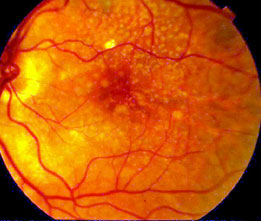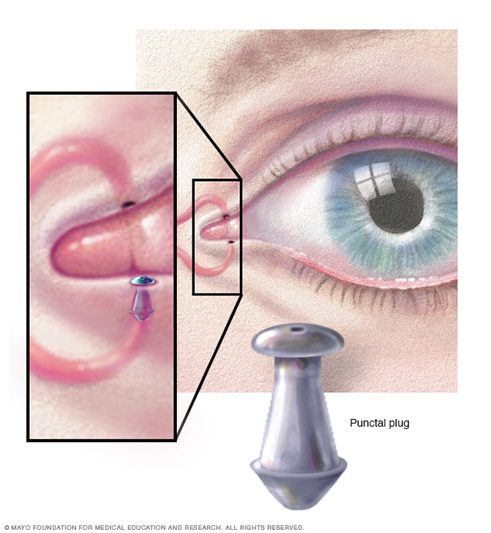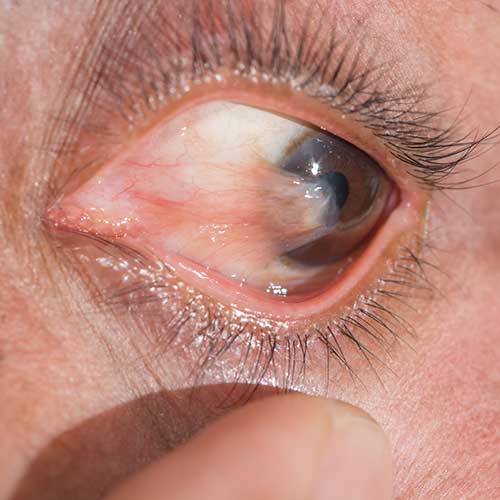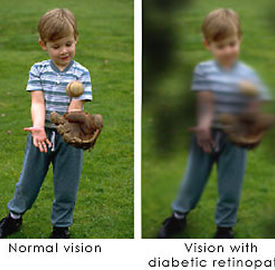Choose Malik Eye Care for New York’s highest quality treatment of eye diseases including macular degeneration, diabetic retinopathy, blepharitis, dry eye, pterygium and more.
Macular Degeneration
 Macular degeneration is a relatively common problem for people as they age. The macula is a part of the retina. A healthy macula is necessary for centralized vision and focus necessary to effectively read or drive. When the macula begins to deteriorate, central vision loss can occur.
Macular degeneration is a relatively common problem for people as they age. The macula is a part of the retina. A healthy macula is necessary for centralized vision and focus necessary to effectively read or drive. When the macula begins to deteriorate, central vision loss can occur.
There are two types of macular degeneration, wet and dry. Wet macular degeneration is neovascular, meaning that blood vessels begin to grow in an area where they should not. In wet macular degeneration, new blood vessel growth occurs in the macula. Wet AMD may lead to blind spots in the central vision. Dry macular degeneration is non-neovascular and is characterized by a thinning of the macula and accumulation of pigment in the macula. While dry macular degeneration is not as severe as wet macular degeneration, it can lead to central vision loss. Dry AMD may lead to wet AMD (and does in about 10% of cases).
Although macular degeneration cannot currently be cured, treatment options do exist. Treatments are aimed at slowing the progression of the disease and improving vision when possible.
Diabetic Retinopathy
If you have diabetes, your body can’t use or store sugar properly. When blood sugar gets too high, it can damage the blood vessels in your eyes. This damage may lead to diabetic retinopathy. In fact, the longer someone has diabetes, the more likely he is to have retinopathy. In later stages, the disease may lead to new blood vessel growth over the retina. The new blood vessels can cause scar tissue to develop, which can pull the retina away from the back of the eye. This is known as retinal detachment, and it can lead to blindness if untreated. In addition, abnormal blood vessels can grow on the iris, which can lead to glaucoma.
Treatment
Diabetic retinopathy can be treated with laser photocoagulation to seal off leaking blood vessels and destroy new growth. Laser photocoagulation doesn’t cause pain, because the retina does not contain nerve endings.
In some patients, blood leaks into the vitreous humor and clouds vision. At that time, we may choose to simply wait to see if the clouding will dissipate on its own, a period called “watchful waiting.” A procedure called a vitrectomy removes blood that has leaked into the vitreous humor. The body gradually replaces lost vitreous humor, and vision usually improves.
If diabetic retinopathy has caused your body to form a cataract, it can be corrected surgically. Small studies using investigational treatments for diabetic retinopathy have demonstrated significant vision improvement for individuals who are in early stages of the disease. Two treatments that are closely related, Lucentis and Avastin, may be able to stop or reverse vision loss, similar to very promising results that have been reported when the two drugs have been used as treatments for macular degeneration.
Early detection is why it is so important for diabetics to have a dilated eye exam at least once a year.
Blepharitis
Blepharitis is inflammation of the eyelids, occurring particularly at the lid margins. It’s a common disorder and may be associated with a low-grade bacterial infection or a generalized skin condition.
Blepharitis occurs in two forms: anterior blepharitis and posterior blepharitis.
Anterior blepharitis affects the front of the eyelids, usually near the eyelashes. The two most common causes of anterior blepharitis are bacteria and a skin disorder called seborrheic dermatitis, which causes itchy, flaky red skin.
Posterior blepharitis affects the inner surface of the eyelid that comes in contact with the eye. It is usually caused by problems with the oil (meibomian) glands in the lid margin. Posterior blepharitis is more common than the anterior variety, and often affects people with a rosacea skin type.
Dry Eye
While dry eyes may seem like a minor inconvenience, anyone who is forced to deal with it on a continuous basis, will tell you that frequently dealing with dry eyes can become more than just a nuisance. Not only do dry eyes create a constant distraction and irritation, the effects of the dryness and the rubbing that becomes inevitable can leave you looking less than your best. To keep yourself at the top of your game professionally and personally, it is wise to take action to alleviate your dry eyes.
The causes of dry eyes vary and it can sometimes be difficult to determine the source of the problem. Typically allergies or sensitivities to pollens, pet dander, dust mites, or the perfumes and scents used in many products are the culprits. One way to determine the cause of dry eyes is to reduce or eliminate potential allergens and take careful note of what triggers the symptoms. While there are many over the counter medications and eye drops that can be used to combat dry eyes, your optometrist will be able to provide you with a personalized approach to your problem and offer an individualized solution.
Punctal plugs are tiny, biocompatible devices that can be inserted into tear ducts to block drainage. This increases the eye’s tear film and surface moisture to help relieve certain forms of dry eye. Also known as punctum plugs, lacrimal plugs or occluders, these devices often are no larger than a grain of rice.
Punctal plugs usually are considered when non-prescription or prescription eye drops fail to relieve your dry eye condition.

Pterygium
A pterygium is a growth of scar tissue and blood vessels on the surface of the eye, known as the cornea. Normally, the outer surface of the eye is clear and smooth. However, when damaged by overexposure to UV light, the growth can extend across the cornea, causing foreign body sensation, irritation, redness, and eventually, visual disturbances. Left unchecked, it may eventually cause loss of vision.
A physical examination of the eye and eyelids under a high-powered microscope, known as a slit lamp, is needed to diagnose your pterygium. If your pterygium is not causing visual disturbances or discomfort, you may not require medical treatment. Instead, your pterygium will be monitored for any changes and you’ll be instructed on ways to prevent further sun damage by using hats and/or sunglasses.
For more information about eye diseases, diagnosis and treatment options, request an appointment Malik Eye Care serving the people of Manhattan, Jackson Heights, Hollis, Forest Hills, Hicksville and more.


